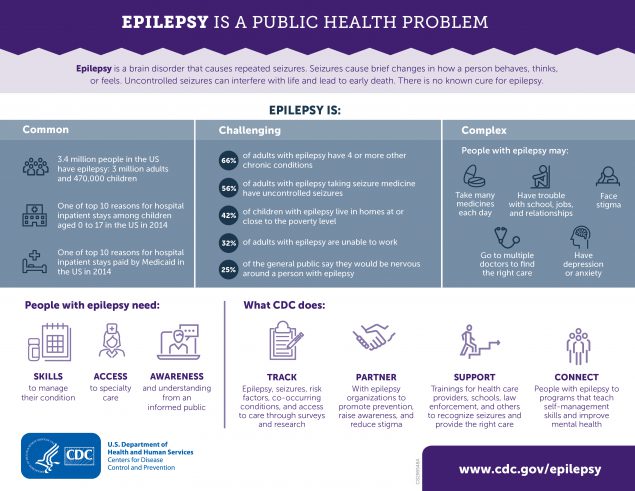Epilepsy Is a Public Health Problem- Text Description

Download High Resolution Image.
Text Description
Epilepsy is a public health problem.
Epilepsy is a brain disorder that causes repeated seizures. Seizures cause brief changes in how a person behaves, thinks, or feels. Uncontrolled seizures can interfere with life and lead to early death. There is no known cure for epilepsy.
Epilepsy is common.
- 4 million people in the United States have active epilepsy—3 million adults and 470,000 children. (See CDC’s definition of active epilepsy below this text description.)
- [Illustration of a group of 7 people]
- Epilepsy was one of the top 10 reasons for hospital inpatient stays among children aged 0 to 17 years in the United States in 2014.
- [Illustration of a hospital]
- Epilepsy was one of the top 10 reasons for hospital inpatient stays paid by Medicaid in the United States in 2014.
- [Illustration of an empty patient bed]
Epilepsy is challenging.
- 66% of adults with epilepsy have 4 or more other chronic conditions.
- [Illustration of “66%” with a circle around it]
- 56% of adults with epilepsy taking seizure medicine have uncontrolled seizures.
- [Illustration of “56%” with a circle around it]
- 42% of children with epilepsy live in homes at or close to the poverty level.
- [Illustration of “42%” with a circle around it]
- 32% of adults with epilepsy are unable to work.
- [Illustration of “32%” with a circle around it]
- 25% of the general public say they would be nervous around a person with epilepsy.
- [Illustration of “25%” with a circle around it]
Epilepsy is complex.
People with epilepsy may:
- Take many medicines each day.
- [Illustration of pills]
- Go to multiple doctors to find the right care.
- [Illustration of a stethoscope]
- Have trouble with school, jobs, and relationships.
- [Illustration of a person sitting on the floor]
- Have depression or anxiety.
- [Illustration of someone’s head with a brain inside]
- Face stigma.
- [Illustration of a person resting their head on their hand]
People with epilepsy need:
- Skills to manage their condition.
- [Illustration of a calendar and pill box]
- Access to specialty care.
- [Illustration of a headshot of a medical professional]
- Awareness and understanding from an informed public.
- [Illustration of a person talking]
What CDC Does
- CDC tracks epilepsy, seizures, risk factors, co-occurring conditions, and access to care through surveys and research.
- [Illustration of a pencil and paper on clipboard]
- CDC partners with epilepsy organizations to promote prevention, raise awareness, and reduce stigma.
- [Illustration of 2 people shaking hands]
- CDC supports trainings for health care providers, schools, law enforcement, and others to recognize seizures and provide the right care.
- [Illustration of a person stepping up stairs]
- CDC connects people with epilepsy to programs that teach self-management skills and improve mental health.
- [Illustration of 4 people gathered in a cluster]
Definitions
In the infographic above, the following statistics refer to people with active epilepsy:
- 4 million people in the United States have epilepsy—3 million adults and 470,000 children.
- 66% of adults with epilepsy have 4 or more other chronic conditions.
- 56% of adults with epilepsy taking seizure medicine have uncontrolled seizures.
- 32% of adults with epilepsy are unable to work.
What is Active Epilepsy?
An adult aged 18 years or older has active epilepsy if they report they have a history of doctor-diagnosed epilepsy or seizure disorder and
- Are currently taking medication to control it or
- Had one or more seizures in the past year (or both) (from the National Health Interview Survey, 2015).
A child aged 17 years or younger has active epilepsy if their parent or guardian reports:
- That a doctor or health care provider has ever told them that their child had epilepsy or seizure disorder, and
- Their child currently has epilepsy or seizure disorder (from the National Survey of Children’s Health, 2011-2012).
Sources
Agency for Health Research and Quality. HCUP Fast Stats. Healthcare Cost and Utilization Project (HCUP) website; 2017. www.hcup-us.ahrq.gov/faststats/national/inpatientcommondiagnoses.jsp. Accessed February 19, 2019.
Cui W, Kobau R, Zack MM, Buelow JM, Austin JK. Recent changes in attitudes of US adults toward people with epilepsy — Results from the 2005 SummerStyles and 2013 FallStyles surveys. Epilepsy Behav. 2015;52:108–118. doi:10.1016/j.yebeh.2015.08.040.
Cui W, Kobau R, Zack MM, Helmers S. Marshalyn Yeargin-Allsopp M. Seizures in children and adolescents aged 6–17 years – United States, 2010–2014. MMWR Morb Mortal Wkly Rep. 2015;64(43):1209–1214. doi: 10.15585/mmwr.mm6443a2.
Kadima NT, Kobau R, Zack MM, Helmers S. Comorbidity in Adults with Epilepsy — United States, 2010. MMWR Morb Mortal Wkly Rep. 2013;62(43):849–853.
Kobau R, Cui W, Kadima N, et al. Tracking psychosocial health in adults with epilepsy—estimates from the 2010 National Health Interview Survey. Epilepsy Behav. 2014;41:66–73. doi: 10.1016/j.yebeh.2014.08.002.
Tian N, Boring M, Kobau R, Zack M, Croft J. Active Epilepsy and Seizure Control in Adults — United States, 2013 and 2015. MMWR Morb Mortal Wkly Rep. 2018;67(15):437–442. doi: 10.15585/mmwr.mm6715a1.
Zack MM, Kobau R. National and state estimates of the numbers of adults and children with active epilepsy — United States, 2015. MMWR Morb Mortal Wkly Rep. 2017;66:821–825. doi: 10.15585/mmwr.mm6631a1.